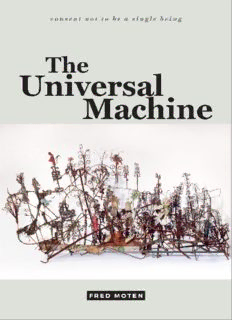
The Universal Machine PDF
Preview The Universal Machine
The Universal Machine This page intentionally left blank consent not to be a single being The Universal Machine FRED MOTEN duke university press durham and london 2018 © 2018 Duke University Press All rights reserved Printed in the United States of Amer ic a on acid- free paper ∞ Designed by Amy Buchanan Typeset in Miller by Westchester Publishing Services Library of Congress Cataloging- in- Publication Data Names: Moten, Fred, author. Title: The universal machine / Fred Moten. Description: Durham : Duke University Press, 2018. | Series: Consent not to be a single being ; [v. 3] Identifiers: lccn 2017036792 (print) | lccn 2017056619 (ebook) isbn 9780822371977 (ebook) isbn 9780822370468 (hardcover : alk. paper) isbn 9780822370550 (pbk. : alk. paper) Subjects: lcsh: Black race— Philosophy. | Blacks— Race identity— Philosophy. | Philosophy, Black. | Racism— Philosophy. Classification: lcc ht1581 (ebook) | lcc ht1581 .m6846 2018 (print) | ddc 305.89601—d c23 lc rec ord available at https:// lccn . loc.g ov/ 2017036792 Cover art: Thornton Dial, Monument to the Minds of the Little Negro Steelworkers, 2001–3. Steel, wood, wire, twine, artificial flowers, ax blade, glass bottles, animal bones, cloth, tin cans, paint-can lids, and enamel; 38 x 76 x 46 inches. © 2018 Estate of Thornton Dial / Artists Rights Society (ars), New York. CONTENTS Acknowl edgments / vii Preface / ix 1. There Is No Racism Intended / 1 2. Refuge, Refuse, Refrain / 65 3. Chromatic Saturation / 140 Notes / 247 Works Cited / 271 Index / 281 This page intentionally left blank ACKNOWL EDGMENTS Earlier iterations of some of the writing collected here appeared in the jour- nals African Identities, Criticism, and South Atlantic Quarterly as well as in the following books: The Oxford Handbook of Critical Improvisation Stud- ies, ed. George E. Lewis and Benjamin Piekut (Oxford University Press); Hannah Arendt zwischen den Disziplinen, ed. Ulrich Baer and Amir Eshel (Wallstein Verlag); and Fanon postcoloniale: I dannati della terra oggi (Ombre Corte). This page intentionally left blank PREFACE The Universal Machine is a monograph discomposed. Riding the blinds gone way off the rails. Though a certain movement might be discerned from object to thing to no- thingness, in general, and in the generative absence of a teleo- logical princi ple, what you have here is a swarm. I hope it’s also a party cum polygraph, establishing truth by feel(ing) despite juridical and philosophical inadmissibility. The swarm has no standing, trou bles understanding’s proper subjects and objects, even when both are radically misunderstood as things. It is not so much antithetical to the rich set of variations of phenomenologi- cal regard; rather, it is phenomenology’s exhaust and exhaustion. On the one hand, phenomenology’s comportment toward the thing itself (as given in experience, as consciousness) is deformed by an insufficient attention to the thing itself; on the other hand, phenomenology’s assumption of thingly indi- viduation renders no-t hingness unavailable and unavowable. What remains of phenomenology in this fallenness and being-t hrown? The social life of no- things bumps and thuds and grunts in plain song. When phenomenol- ogy is exhausted, no- thing insists on social life. Frantz Fanon’s adherence to phenomenology’s possibilities is given as a kind of manifesto for sociogeny expressing disbelief in social life, wherein the new discipline he invokes and practices takes the form of an autopsy report. It is pathontology (as opposed to paraontology— W. E. B. Du Bois had already discovered the necessity of an improvisation [a movement; a dehiscence; a quickening] of ontology for the study of social life, as Nahum Chandler teaches us) and therefore relatively unattuned to (what) remains, the exhausted, its marked breath and black lung.1 High lonesomeness is both an effect of and a remedy for coal dust, which is moved ground. Edmund Husserl, too, is phenomenology’s exhaust, as are Emmanuel Levinas, Hannah Arendt, and Fanon, among others. This is to say that phenomenology’s spirit, its song, its animation, its aspiration is its exhaust, the thing that it expels, that it abjures, as disor ga nized, as an an- archic princi ple of disorg a niz a tion or constant reor ga ni za tion, the enformal,
Description: